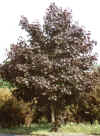 |
 |
 |
 |
 |
| Many people think
that copper coloured trees are all Beeches. In fact many species of trees have
copper varieties. This one is an Acer (Maple). |
Elder is a small
tree, very common in hedgerows and roadside verges, as well as in gardens. The fragrant
umbels of flowers can be used to flavour a cool summer drink called elderflower champagne,
or to make elderflower wine. Later in the year bunches of black berries provide autumn
food for birds and can be gathered to make elderberry wine. |
Ne'er cast a
clout 'til May be out. The old saw refers to the May tree or hawthorn. Here are two
of them in full bloom. Some hawthorns have pink blossom. |
A pair of Horse
Chestnut trees growing side by side in a Surrey park. They are covered in creamy coloured
"candelabras" of flowers which will later develop into conkers.
The red flowered horse chestnut is a different, but closely related, species.
Flowers |
Magnolia, like
many spring-flowering trees, flowers before its leaves appear. |
| Mike Freedman |
Mike Freedman |
Mike Freedman |
Mike Freedman |
Mike Freedman |
| 148Kb |
127Kb |
159Kb |
126Kb |
127Kb |
| Return to Photo Index |
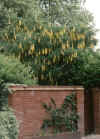 |
 |
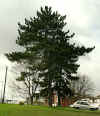 |
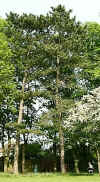 |
 |
| Decorative, but
deadly. Laburnum is commonly grown in gardens for its beautiful early summer display of
pnaicles of yellow flowers. It is a member of the pea family and produces pods of little
black peas, which are very poisonous. (This photo
is a bit blurry. I hope to get a better picture for next year!) |
A fine Oak tree by
the side of a Surrey road. Notice how the tree has far more growth on the side away from
the road. |
In spring: A Pine
(evergreen) with an Oak (deciduous) in the background |
A pair of pine
trees reach up between other trees in a Surrey park. |
Plane and Sycamore
are often mistaken for each other, although they are not closely related. This photo shows
the more angular leaves of a Plane tree as well as one of its balls of fruit. |
| Mike Freedman |
Mike Freedman |
Mike Freedman |
Mike Freedman |
Mike Freedman |
| 165Kb |
149Kb |
109Kb |
53Kb |
166Kb |
| Return to Photo Index |
 |
 |
 |
 |
 |
| Another, clearer
view of the very angular leaves of the Plane tree. |
Although its
leaves are similar in shape to those of the Plane, the Sycamore has much less ngular
leaves. Its flowers, too are quite different, being drooping clusters of tiny green wind
pollinated flowers. |
A pair of Willows
just coming into leaf. The weeping form is common in Willows but other trees can weep,
too. |
In a woodland, the
canopy of leaves lets through only a dappled light. In this photo you can see
ferns making the most of the limited light. |
A willow house
makes a popular play area in a school. This one has just had its Autumn "hair
cut" but will be covered in leaves by the summer, when the grass is dry enough to
play on. |
| Mike Freedman |
Mike Freedman |
Mike Freedman |
Mike Freedman |
Mike Freedman |
| 136Kb |
149Kb |
100Kb |
157Kb |
79Kb |
| |
 |
 |
 |
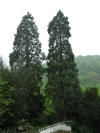 |
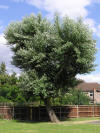 |
|
Some trees regrow readily from cut
trunks. For thousands of years people have cut hazel back to ground
level so that it will sprout straight sticks that can be used for
fencing and house-building. This process is called coppicing.
Traditionally a coppiced woodland would be divided into 7 areas, one
being cut back each year in rotation. |
Catalpa,
the Indian Bean Tree, originates in North America and is often grown
in parks and ornamental gardens. It has large white flowers followed
by long dark brown, almost black pods. It is not a member of the pea
family. |
The giant
sequoia (or giant redwood) is often wrongly called Welllingtonia.
It's scientific name is actually Sequoiadendron giganteum. These
trees are known to be able to live for more than 3000 years
and can become the largest trees of all (largest volume, rather than
height). The bark is very thick and fibrous |
The white
poplar is a member of the Poplar or Aspen family. Notice that it is
not a tall thin tree with upward growing branches like the well
known Lombardy poplar, but a large tree with a spreading crown.
There is a photo of the same tree in winter on the Winter page of
our Seasons section. |
|
Mike Freedman |
|
73Kb |
75Kb |
579Kb |
334Kb |
613Kb |
|
|
 |
 |
|
|
|
|
You can tell how old a tree is by counting its rings.
Each year the tree grows a new layer of wood just below the bark.
The wood that grows in spring has a different structure to the later
summer wood, so looks different, giving the tree clear annual rings. |
Trees and shrubs that grow in windy places, such as
near the coast suffer from "wind pruning". The wind (especially near
the sea where the air contains salt particles) kills the buds on the
windward side of the plant, those on the leeward side are protected
and grow normally. The tree thus takes on a lopsided shape. like
these near the cliff tops in East Sussex. |
|
|
|
|
Mike Freedman |
|
|
|
|
808Kb |
550Kb |
|
|
|